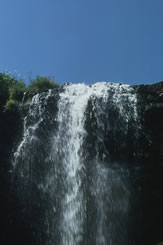 African herdsmen use mobile phones for drought alerts
African herdsmen use mobile phones for drought alerts
East African livestock herders are using mobile phones to send early warnings of drought, part of a new effort to avert disasters like the one two years ago that required a massive EU humanitarian response.
Pastoralists in remote regions of northern Kenya and southern Ethiopia are collecting data on wells and water reserves and sending it by text message to regional databases, doing in minutes what it took days or weeks to do before by letters.
“Having this information the same day means [relief organisations] are working with very up-to-date information,” said Alun McDonald, a Nairobi-based spokesman for the charity group Oxfam, which launched the drought-alert system as pilot project last year and now wants to expand it.
“The speed does make the response more efficient and more timely,” McDonald said by telephone on Friday (12 April).
Timing can be critical in remote regions where communication and transport infrastructure are poor. The initial slow response to the 2011 drought was blamed in part on spotty data collection from across a vast swathe of the Horn of Africa.
Since then, mobile network coverage has improved, clearing the way for efforts like Oxfam’s early-alert project.
EU response to drought
East Africa saw one of its worst droughts in more than 50 years in 2011, causing a humanitarian and refugee crisis as crops and livestock withered. At the height of the crisis, 13 million people needed food and water aid in Djibouti, Ethiopia, Kenya and Somalia.
By mid-2011, the European Commission and EU states pledged €706 million, or one-third of the international aid response.
The crisis also prompted the European Parliament, in a September 2011 resolution, to urge the EU to do more through its development aid to buttress the region against droughts and other climate shocks. The resolution was adopted a month before the European Commission unveiled a new aid agenda aimed at giving higher priority to the world's most fragile nations.
Pastoralists often have little recourse but to send letters to warn government disaster agencies and humanitarian workers about impending water problems, and by then “several weeks have passed,” McDonald told EurActiv be telephone from Nairobi.
The text messages being used through the Oxfam pilot project can do that in minutes.
So far, Oxfam is using private funding and phones provided by Finnish telephone manufacturer Nokia. The charity now wants to expand to other parts of East Africa prone to devastating climate events.
Doing more with mobile technology
Mobile technology is increasingly being used to provide humanitarian warnings and in getting help to hard-hit areas faster.
Another charity, Save the Children, has launched a community-based programme in the arid Ethiopia-Somalia border region using mobile messaging to improve food distribution during times of drought. The programme that receives support from the European Commission.
The United Nations mobile messaging to improve information sharing between needy communities and relief coordinators, while the UN’s Food and Agriculture Organization has supported a project in East Africa to provide early warnings about the outbreak of livestock diseases.
“Cellular phones eliminate delays in receiving field data, since all the information is relayed via the mobile network,” Robert Allport, an FAO official in Kenya, said in a statement last month. “In addition, the information is assigned a geographic location, so locations are extremely accurate and available in real-time.”
Oxfam hopes to expand the drought warning system to other parts of Ethiopia and Kenya, which are prone to cyclical food crises, and other vulnerable areas of East Africa.
The organisation has provided 60 phones to pastoralists who send data via text messages each day, information that is collated by Oxfam through two databases in Ethiopia and a third in Kenya and forwarded to national and international relief organisations. The phones are also used to take photos to verify the written data.
| Contact information | n/a |
|---|---|
| News type | Inbrief |
| File link |
http://www.euractiv.com/development-policy/text-messages-deliver-early-warn-news-519088#.UWvzSOWwR4Q.facebook |
| Source of information | Euractiv.com |
| Keyword(s) | drought |
| Subject(s) | AGRICULTURE , FINANCE-ECONOMY , HYDRAULICS - HYDROLOGY , INFORMATION - COMPUTER SCIENCES , MEASUREMENTS AND INSTRUMENTATION , METHTODOLOGY - STATISTICS - DECISION AID , NATURAL MEDIUM , RISKS AND CLIMATOLOGY , TOOL TERMS , WATER DEMAND |
| Relation | http://www.semide.net/topics/WaterScarcity |
| Geographical coverage | EU, Kenya,Ethiopia, |
| News date | 15/04/2013 |
| Working language(s) | ENGLISH |
 you are not logged in
you are not logged in





